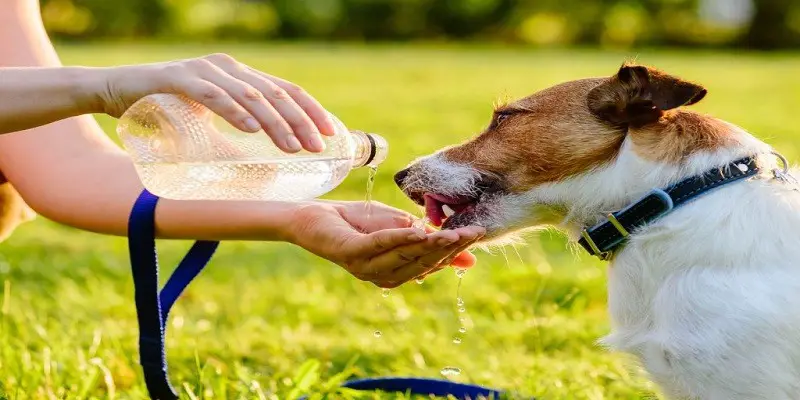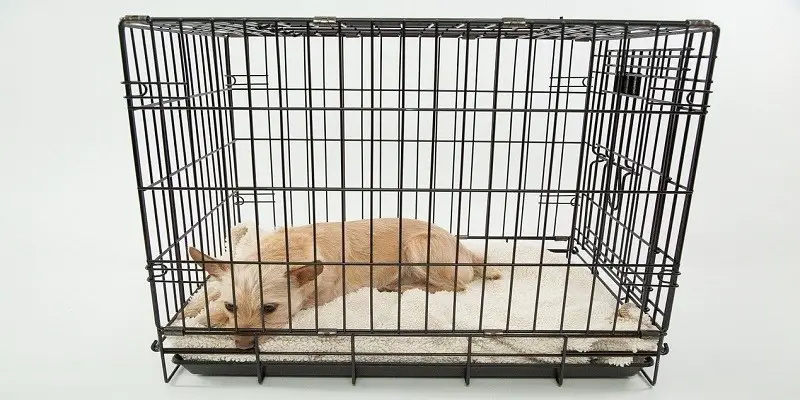Last Updated on September 17, 2023 by Pauline G. Carter
A dog can go without water for about three to five days. Proper hydration is essential for dogs to maintain their overall health and well-being.
Just like humans, dogs need water to survive, as it helps regulate their body temperature, aids digestion, and eliminates waste. Without water, dogs can quickly become dehydrated, leading to serious health complications. We will explore the importance of water for dogs, signs of dehydration to look out for, and tips on how to ensure your furry friend stays hydrated.
Whether you’re a dog owner or simply curious about pet care, understanding a dog’s water needs is crucial to their health and longevity. So, let’s dive in and learn more about how long a dog can go without water.
The Importance Of Water For Dogs
Water is essential for dogs, but how long can they survive without it? Find out the importance of hydrating your furry friend and learn how much water they need to stay healthy. Keep your dog happy and hydrated to ensure their overall well-being.
Proper hydration is essential for the overall health and well-being of dogs. As a responsible pet owner, it’s crucial to understand the importance of water in a dog’s body. In this section, we will explore the hydration needs of dogs, the role of water in their bodies, and the consequences of dehydration.
Hydration Needs Of Dogs
To maintain optimal health, dogs require an adequate intake of water. Here are some key points regarding their hydration needs:
- Dogs should have access to fresh water at all times.
- The amount of water a dog needs can vary depending on factors such as size, activity level, and the environment.
- On average, a dog should drink about ½ to 1 ounce of water per pound of body weight every day.
- Puppies, nursing mothers, and active dogs may require more water to stay properly hydrated.
- Dogs who consume dry kibble or a dehydrated diet may need additional water to compensate for the lack of moisture in their food.
Role Of Water In A Dog’S Body
Water plays several vital roles in a dog’s body, contributing to various physiological functions:
- Water helps to regulate body temperature, especially during hot weather or physical activity.
- It aids digestion and absorption of nutrients from food.
- Water helps to lubricate joints and cushions organs.
- It supports kidney function by flushing out waste products from the body.
- Water is essential for maintaining healthy skin and coat.
Consequences Of Dehydration In Dogs
Dehydration occurs when a dog loses more fluid than they consume, leading to a water imbalance in the body. Here are some potential consequences of dehydration:
- Reduced energy levels and lethargy
- Dry, sticky gums and sunken eyes
- Loss of appetite and weight loss
- Increased heart rate and panting
- Poor skin elasticity
- Decreased urine output and dark-colored urine
It’s vital to recognize the signs of dehydration and take immediate action if your dog shows any of these symptoms. Dehydration can be a severe condition that requires veterinary attention.
Remember, providing your dog with access to fresh water at all times and monitoring their hydration levels is crucial for their overall health and well-being.
Factors Affecting A Dog’S Water Intake
When it comes to a dog’s water intake, several factors can affect how long they can go without water. These include their age, size, activity level, and the weather conditions they are in. It is essential to ensure that dogs always have access to fresh water to stay hydrated and prevent health issues.
Dogs, just like humans, require an adequate amount of water to maintain their overall health and well-being. However, several factors can affect a dog’s water intake. Understanding these factors can help ensure that your furry friend stays properly hydrated. Let’s explore some of the key factors that can influence a dog’s water consumption:
Breed And Size Differences:
- Different dog breeds and sizes have varying water intake needs.
- Larger breeds generally require more water due to their higher body mass and metabolism.
- Smaller breeds may need less water, but it is essential to monitor their hydration levels closely.
Activity Level And Exercise:
- Dogs that engage in more physical activities and exercise tend to require more water.
- Increased activity leads to higher water loss through panting and sweating.
- Ensure that your dog has access to fresh water before, during, and after exercise to prevent dehydration.
Ambient Temperature And Weather Conditions:
- Dogs need more water during hot weather or in environments with high temperatures.
- Hot weather can cause excessive panting and sweating, leading to increased water loss.
- Always provide ample water and shade to keep your dog cool and hydrated.
Dietary Factors:
- The type of food a dog consumes can also impact their water intake. Dry dog food tends to have lower moisture content, necessitating higher water consumption.
- Dogs on wet or raw diets may need less supplementary water due to the higher moisture content of their food.
Illness Or Medical Conditions:
- Certain health issues or medications can affect a dog’s water intake.
- Dogs with fever, diarrhea, or vomiting may become dehydrated quickly and require extra water.
- Consult your veterinarian if your dog’s water intake significantly increases or decreases without any apparent reason.
Age And Life Stages:
- Puppies and senior dogs have different water intake requirements compared to adult dogs.
- Puppies need more water due to their active growth phase, while senior dogs may require an enhanced water intake to support their aging bodies.
Taking into account these factors, it is crucial to monitor your dog’s water intake and ensure they have access to clean and fresh water at all times. By understanding their specific needs, you can ensure that your furry friend remains hydrated and healthy.
Signs And Symptoms Of Dehydration In Dogs
Dehydration in dogs can cause various signs and symptoms, such as increased thirst, dry mouth, reduced urination, and sunken eyes. It is vital to ensure that dogs have access to fresh water regularly, as they can typically only go a few days without water before experiencing severe health complications.
Dehydration in dogs can be a serious condition that requires prompt attention. As a responsible dog owner, it is essential to know the signs and symptoms of dehydration to ensure the well-being of your furry friend. By recognizing these indicators early on, you can take the necessary steps to prevent further complications.
Here are some important signs to watch out for:
- Decreased skin elasticity: Gently lift the skin on the back of your dog’s neck and release it. In a well-hydrated dog, the skin will quickly snap back into place. However, if your dog is dehydrated, the skin will take more time to return to its normal position, indicating decreased elasticity.
- Dry mouth and gums: Healthy dogs should have moist gums and a wet, shiny nose. If you notice that your dog’s mouth and gums appear dry and sticky, it could be a sign of dehydration. Lack of moisture in these areas can also lead to bad breath and discomfort for your canine companion.
- Lethargy and weakness: Dehydration can cause dogs to feel tired and sluggish. If your dog seems unusually lethargic or weak, it may be a result of insufficient water intake. Pay close attention to changes in your dog’s behavior and energy levels, as this can indicate dehydration.
Recognizing these signs and symptoms is vital to ensure your dog’s well-being. If you suspect dehydration, it is crucial to provide your dog with clean, fresh water immediately. In severe cases or if your dog’s condition worsens, it is recommended to seek veterinary assistance for proper diagnosis and treatment.
Remember, prevention is always better than cure. Ensure your dog has constant access to clean water, especially during hot weather or after intense physical activities. By staying vigilant and addressing dehydration promptly, you can keep your furry friend happy, healthy, and hydrated.
What To Do If Your Dog Is Dehydrated
If your dog is dehydrated, it’s important to act quickly. Offer small amounts of water frequently, and consider adding electrolyte solution to their water to help replenish lost fluids. Remember, dogs can only go without water for a short period of time, so taking prompt action is crucial.
Dehydration in dogs can be a serious concern and needs to be addressed promptly. If you suspect that your dog is dehydrated, it is important to take immediate action to rehydrate them. Here are some rehydration methods you can try at home and when it is time to seek veterinary help:
Rehydration Methods At Home:
- Offer fresh water: Make sure your dog has access to clean and fresh water at all times. Sometimes, dehydration can be easily remedied by encouraging your dog to drink more water.
- Ice cubes: Some dogs may be more inclined to lick ice cubes than drink water. Consider offering ice cubes as an alternative way for your dog to stay hydrated.
- Pedialyte or electrolyte solutions: If your dog is refusing to drink water, you can try offering Pedialyte or electrolyte solutions specifically formulated for dogs. These solutions can help replenish electrolytes and fluids in their body.
- Wet food or water-rich treats: Feeding wet food or water-rich treats can provide additional hydration for your dog. These options have a higher water content and can be an enticing way to encourage them to consume more fluids.
When To Seek Veterinary Help:
It is crucial to monitor your dog’s dehydration closely, as severe cases may require veterinary intervention. Consider seeking veterinary help if:
- Your dog’s dehydration symptoms worsen or do not improve after trying at-home rehydration methods.
- Your dog continues to refuse water or is unable to keep fluids down.
- You notice other concerning symptoms such as excessive lethargy, dry gums, sunken eyes, or panting.
Remember, timely veterinary care can play a vital role in diagnosing and treating the underlying cause of dehydration, and professional guidance should be sought in severe cases.
By taking quick action and implementing these rehydration methods, you can help your dog combat dehydration and promote their overall well-being.
Preventing Dehydration In Dogs
Dogs can go without water for a maximum of three to five days, but it’s crucial to prevent dehydration. Providing access to clean and fresh water at all times is key to preventing health issues and ensuring your dog’s well-being.
Dogs, just like humans, depend on water for survival. Dehydration can have serious health consequences for our furry friends. As responsible pet owners, it’s crucial to ensure that our dogs have access to clean and fresh water at all times.
Here are some tips to help prevent dehydration in dogs:
Providing Access To Clean And Fresh Water:
- Ensure that your dog always has access to clean and fresh water in a clean bowl or water dispenser.
- Regularly clean the water bowl to prevent any bacterial growth that may deter your dog from drinking.
- Keep an eye on the water level throughout the day and refill as needed to ensure a continuous supply.
- During hot weather or intense physical activity, consider placing multiple water sources in different areas of your home or yard to make it more accessible for your dog.
- If you notice your dog is hesitant to drink water from a certain location, try moving the water bowl to a different spot and see if they drink more readily.
Encouraging Regular Water Intake:
- Establish a water-drinking routine with your dog. Encourage them to drink water after meals and physical activity.
- If you have a dog that tends to be less interested in drinking water, consider adding wet food or water to their dry kibble to increase their moisture intake.
- During walks or outdoor adventures, bring a collapsible water bowl or a water bottle with a built-in dispenser. This allows you to offer water to your dog whenever they need it.
- Train your dog to respond to a command that signals it’s time to drink water, making it easier for you to hydrate them during specific situations.
- Monitor your dog’s water intake and ensure they are consuming an adequate amount based on their size and activity level. Consult your veterinarian if you notice any significant changes in their drinking habits.
Water Alternatives For Dogs:
- Consider providing your dog with natural, low-sodium broth or diluted fruit juices (without added sugars) as an occasional alternative water source. These can add flavor and encourage hydration, but they should not replace regular water intake.
- Be cautious when considering other liquid options for dogs. Avoid giving them caffeinated beverages, alcohol, or dairy products, as these can be harmful to their health.
- Some dogs prefer running water, so investing in a pet water fountain can be a great solution to encourage them to drink more. The flowing water can be enticing for many dogs and help keep them hydrated.
Remember, ensuring your dog has access to clean and fresh water throughout the day is crucial for preventing dehydration. Pay attention to their water intake and take the necessary steps to encourage regular hydration. By prioritizing your furry friend’s well-being, you can help them stay healthy and happy.
Summary And Key Takeaways
Dogs should not go more than 24 hours without water, as dehydration can have severe consequences on their health. Ensuring a constant supply of fresh water is crucial for their well-being and proper bodily functions.
Importance of monitoring a dog’s water intake:
- Providing the right amount of water for your dog is essential for their overall health and well-being.
- It is important to monitor your dog’s water intake to ensure they stay hydrated and prevent dehydration.
- Dogs rely on proper hydration for various bodily functions such as regulating body temperature and aiding digestion.
Recognizing signs of dehydration and taking prompt action:
- Dehydration can be dangerous and potentially life-threatening for dogs if not addressed promptly.
- Common signs of dehydration in dogs include dry gums, sunken eyes, loss of skin elasticity, and lethargy.
- If you suspect your dog is dehydrated, provide them with water immediately and consult a veterinarian for further guidance.
How long can a dog go without water:
- Dogs, like humans, cannot survive for long without water.
- The exact duration a dog can go without water depends on several factors, such as their size, activity level, and environmental conditions.
- In general, a healthy adult dog can typically survive for about three to five days without water, but this timeframe can be significantly shorter for puppies, older dogs, or those with existing health conditions.
Tips to ensure your dog’s water needs are met:
- Always provide fresh and clean water to your dog, changing it regularly to prevent bacterial growth.
- Consider investing in a spill-proof water bowl to minimize accidents and ensure your dog has access to water throughout the day.
- If you’re going on a hike or spending a significant amount of time outdoors, bring a portable water container and offer your dog water at regular intervals.
- When traveling, have water readily available for your dog, especially during long car rides or flights.
- If your dog has a decreased water intake or shows signs of dehydration, consult a veterinarian for a proper diagnosis and treatment plan.
Remember, monitoring and meeting your dog’s water needs is crucial for their overall health and vitality. By recognizing signs of dehydration and taking proactive measures to ensure they stay hydrated, you can help your furry companion lead a happy and healthy life.
Frequently Asked Questions For How Long Can A Dog Go Without Water?
Can A Dog Go 8 Hours Without Water?
Yes, a dog can go 8 hours without water, but it’s important to provide regular access to fresh water to stay hydrated.
Is It Ok For A Dog To Go 12 Hours Without Water?
No, it is not okay for a dog to go 12 hours without water as it can lead to dehydration and health issues.
Can A Dog Live 5 Days Without Water?
No, dogs cannot survive for 5 days without water as it is essential for their overall health and well-being.
Can Dogs Go 7 Hours Without Water?
Yes, dogs can go without water for up to 7 hours, but it’s important to provide them with regular access to fresh water to stay hydrated.
How Long Can A Dog Survive Without Water?
A dog can survive for around 3-5 days without water, depending on various factors like age, health, and weather conditions.
Conclusion
It is crucial to understand the importance of providing dogs with an adequate supply of water. While they can survive for a few days without food, going without water for even a day can have severe consequences for their health.
Dehydration in dogs can lead to kidney damage, urinary tract infections, and even organ failure. It is essential to ensure that your furry friend has access to clean, fresh water at all times, especially during hot weather or periods of physical exertion.
Additionally, monitoring your dog’s water intake and encouraging them to drink regularly can help prevent dehydration. Remember to take into account factors such as age, activity level, and weather conditions when determining the amount of water your dog needs. By prioritizing their hydration needs, you can ensure that your beloved pet remains healthy and happy for years to come.
About Author (Pauline G. Carter)

Pauline G. Carter is a well-known pet blogger who has written about the world of pets for several years. She is passionate about pets, from cats and dogs to birds, reptiles, and poultry. Her blog, which is updated regularly, is filled with articles and guides on pet care, nutrition, and training. She also shares her experiences and observations on pet ownership, making her blog relatable and informative for pet lovers. She is a true animal advocate and is dedicated to promoting responsible pet ownership. Let’s Go …





